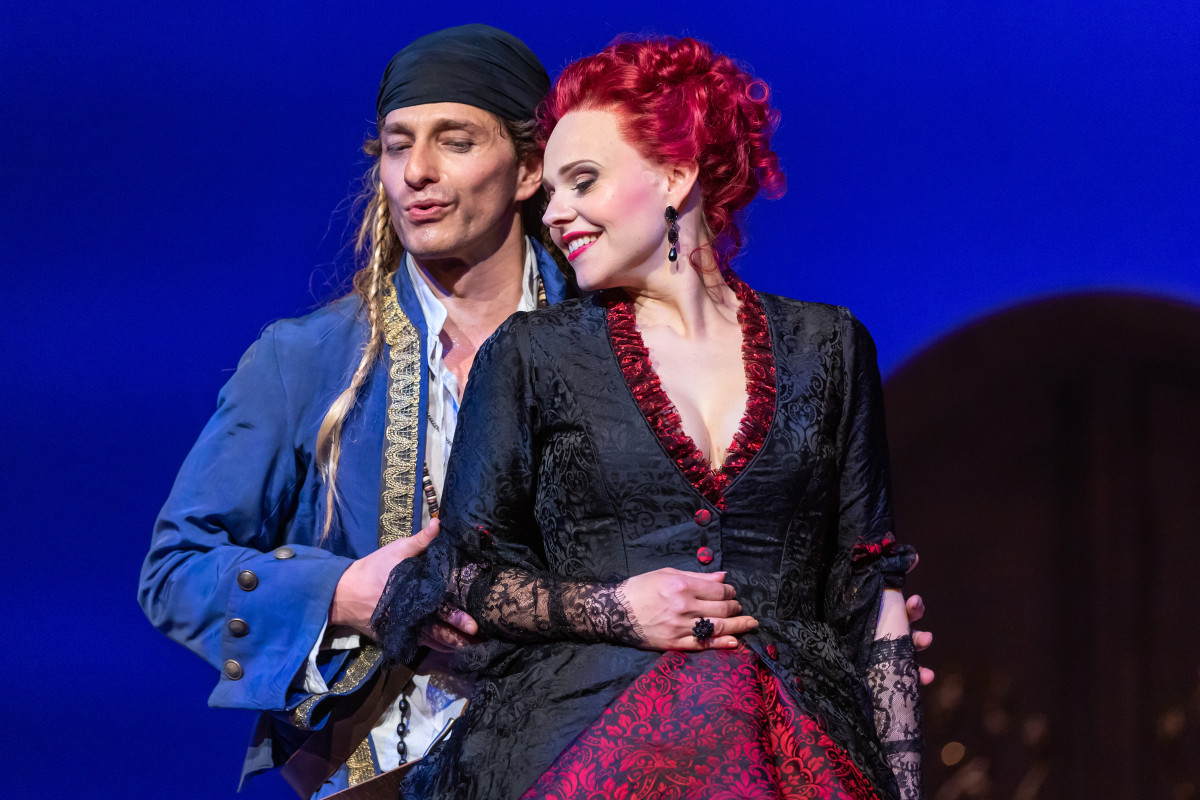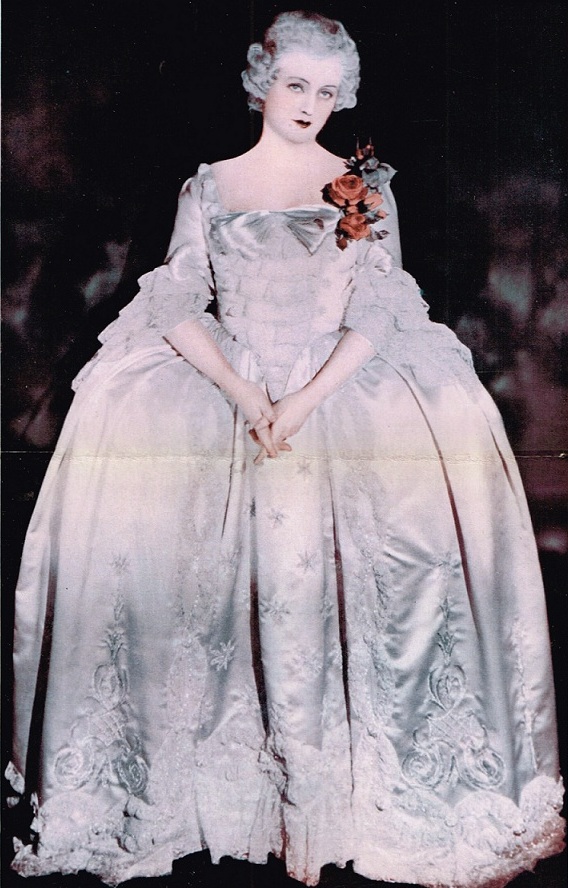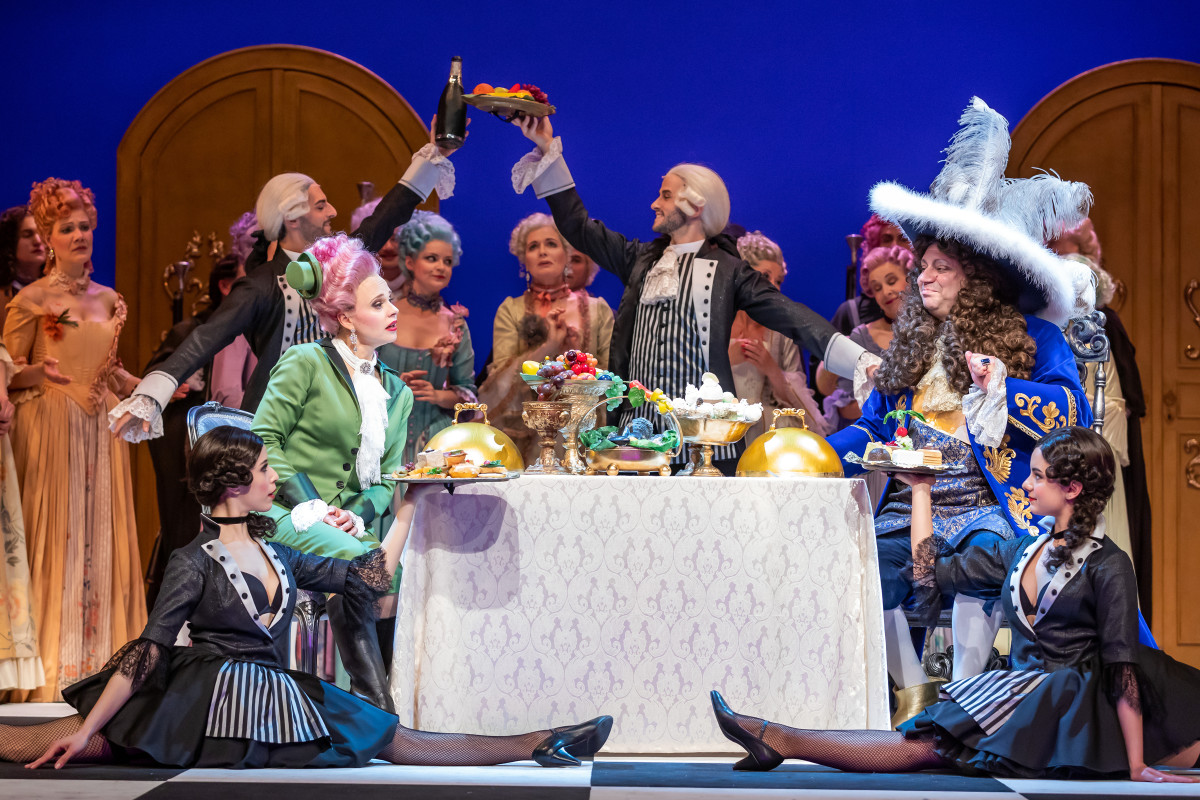John Groves
Operetta Research Center
7 June, 2019
The 1922 Madame Pompadour is not only one of Leo Fall’s last stage works (he died in 1925), it is also one of the most well-known and delightful operettas ever – with one catchy tune after the other. And a sexualized plot that’s typical of the 1920s in the Weimar Republic. A new production premiered at Musikalische Komödie in Leipzig on 1 June, 2019.

Lilli Wünscher as Madame Pompadour with Adam Sanchez as René at Musikalische Komödie, Leipzig. (Photo: Tom Schulze)
The story? René, Count d’Estrades, who is visiting Paris for a ‘dirty weekend’ picks up a pretty girl who turns out to be the Marquise de Pompadour, mistress of King Louis XV, who discovers she is the half-sister of René’s wife. The rest is an amusing farce about French politics – something rather daring considering that France was German’s arch enemy shortly after WW1, and considering that France did everything to humiliate Germany. Maybe this was Germany’s answer to such humiliations.
The Berlin production, starring the one-and-only Fritzi Massary, was very successful, but even more so was the London staging at Daly’s, where it ran for 13 months in 1923, starring Evelyn Laye, Derek Oldham and Elsie Randolph.

Miss Evelyn Lay as Madame Pompadour.
It is fascinating to think that we have gramophone recordings of all these artistes, so we have knowledge of the style of the originators of these roles.
The director of the new Leipzig production, Klaus Seiffert, clearly knows what he is doing with this show. For a start he uses what seems to be (more or less) the original libretto without any noticable re-writes, and quite witty it proves to be, especially as it is acted with energy and motivation, dovetailing with the musical numbers so that the piece flows speedily along and the structure of the work is clear. Secondly he place the interval between Acts One and Two, even though this does make the second half quiet long – but never dull! Thirdly, although his approach to the show is traditional, the staging of the musical numbers is always inventive, often using the theatre’s Ballet Company (choreography Mirka Mahr) to great effect, as for example during the overture when the story is laid before the audience in dance.

Chorus and Ballet of Musikalische Komödie Leipzig in act 1 of “Madame Pompadour.” (Photo: Tom Schulze)
Both costumes and sets have been designed by Tom Grasshof. Costumes are suitably lavish and ‘of the period,’ but he also has fun by dressing anyone in uniform as if they inhabit French toy town, in red, white and blue stripes.
There is a basic, attractive set allowing use of the full stage as well as several sets of double doors on wheels which are used to confine the action for intimate scenes when needed. These are easily wheeled around by the cast and are especially effective when special ‘entrances’ are needed, such as at the beginning of Act Two. The sets are made even more evocative by superb lighting design (Thorsten Mengel) which achieves the unusual by not only lighting the faces of the actors, but also succeeds in being very atmospheric.

Lilli Wünscher as Madame Pompadour and Jeffrey Krueger as Calicot. (Photo: Tom Schulze)
Mme Pompadour herself is Lilli Wünscher. Not only does she look right, she is very imposing in role. Her Act Three aria, reflecting on how foolish the King makes himself over her, was exquisitely sung, even if earlier in the operetta the tone of her high notes was inclined to spread and lack control.
Radoslav Rydlewski played the role of René at the performance I saw, sharing it with Adam Sanchez. Although costumed in the most outrageous Errol Flynn swashbuckling costume and wig, he did little with the part, lacking the verve that the rest of the cast had and finding the high tessitura difficult.
Andreas Rainer, as his friend Calicot was far more successful in imbuing his role with energy and his effortless baritone was a pleasure to here. An especial highlight was his duet with Mme P: ‘ Josef ach Josef.’ (Noone sings this quite like Massary with her husband Max Pallenberg, it’s one of those recordings from the ‘Hall of Fame’ of operetta history.)
In the soubrette role of Belotte, Pompadour’s maid, Mirjam Neururer proved that she not only has a gorgeous, light, flexible voice, she also has the ability to make her role seem larger than it actually is, and her scenes with Calicot were invariably amusing; for example, the ‘other’ musical number in Act Three: Wenn du meine Wohnung siehst’.
Everyone knows the melody of the waltz in which Mme Pompadour introduces herself – it is one of those melodies that, heard once, just sticks in the memory! One almost doesn’t need the six reprises of it, or parts of it, that I counted in Act One!

Lilli Wünscher as Madame Pompadour and Milko Milev as the King with the ballet company of Musikalische Komödie. (Photo: Tom Schulze)
But there are also many other enjoyable musical numbers, such as Calicot’s ‘Die Pom- Pom- Pompadour’ and various toy town style marches. Act three only has two musical numbers - not even a sung Finale.
Stefan Klingele, who has musically revitalised the Musikalische Komödie recently, ensured that the orchestral playing was suitably stylish, especially when compared to the playing of the Wien Volksoper orchestra on CPO’s recording!

The CPO recording of “Madame Pompadour” with Annette Dasch, from Volksoper Wien.
Whether or not you know the operetta, it is, as I have already said, totally delightful in this new production, but if you go, do try to see a performance with the charismatic Adam Sanchez as Rene.
The Musikalische Komödie is closing for a year in a few weeks for some much needed renovation. It is not before time that money was spent on this 500-seater theatre! The company is moving temporarily to Westbad, about five minutes away.
For more information and performance dates, click here.

Yet again a thorough and most informative review from Mr.Groves. Thank you.